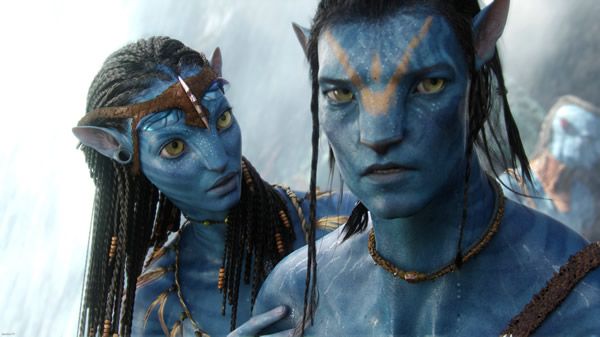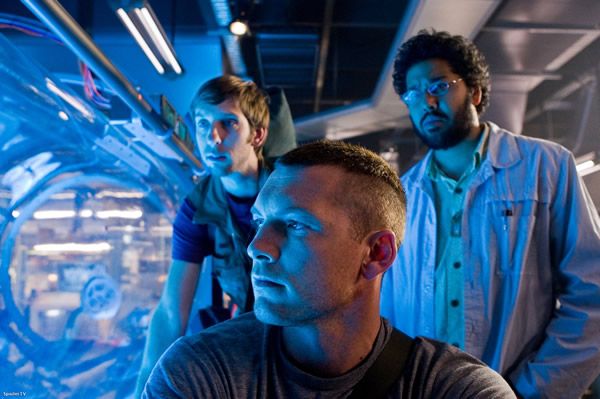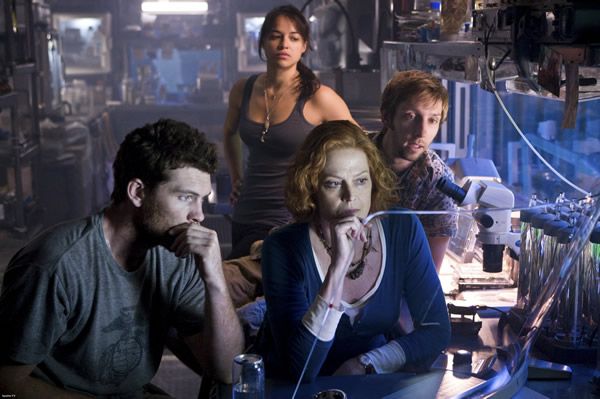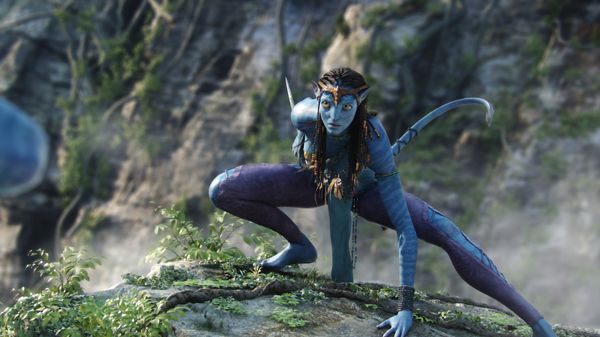Avatar is the most successful film of all time. So it should be no surprise that people went crazy for it. Like really crazy, like becoming suicidal over Pandora not existing crazy. The story of how Jake Sully (Sam Worthington) went to Pandora as a crippled marine, and became a Na’vi (a twelve-foot tall blue catlike creature), then a leader and warrior got to the core of some people, possibly because of how director James Cameron approached his 3-D world. Though the extended collector’s edition does not include the 3-D version of the film, it does have three cuts of the movie, and two disc chocked full of supplements. My review of the Avatar Extended Collector’s edition Blu-ray comes after the jump.
Seeing the film in the theater, I was not one of the film’s champions. The story is very familiar, and I guess I was expecting the film to have sex with me, or something along those lines by the amount of hyperbole the film was attracting. Ultimately, the narrative is a vessel. Knowing how plodding the structure is (and the film is no more or less than the quips about it being Dances with Blu Cats, etc., though my old friend Mike Clark made another good comparison to The Emerald Forrest), on repeated viewings, and removed from the 3-D, I was able to marvel at James Cameron’s world.
And that’s where the film triumphs over its familiar narrative. Yes, it’s a six-legged horse, and many of the creatures are variations on things familiar, but there is so much to marvel at when you’re not really watching the film for a story. And the film succeeds best as a travelogue for a planet that doesn’t exist. The effect of the motion capture, how they got eyes, and the design work is truly the game changer that was asserted on release. Removed from the 3-D, just watching the film, I was truly impressed with how much it all just works. In the theater, I was slightly bored because I was waiting for the film to hit all its familiar beats (and those beats are familiar as all get out), but at home I could just marvel at the design. And how Cameron uses space was more vertiginous at home than theatrically. I guess – for better or worse – I’m just not a fan of 3-D in cinema for anything more than films that understand it’s a gimmick (My Bloody Valentine is a perfect 3-D film).
The narrative is familiar: Jake Sully (Sam Worthington) is a marine who fills in for his recently deceased brother, and goes to Pandora. It’s supposedly a vicious planet, or at least that’s what Colonel Miles Quatrich (Stephen Lang) tells us, and the air is toxic to humans. Jake works with Dr. Grace Augustine (Sigourney Weaver), and Norm Spellman (Joel Moore) at becoming a Na’vi, as they port into their Avatars, a DNA hybrid of themselves with the giant blue cats. Running their operation is Parker Selfridge (Giovanni Ribisi) who is a mercenary when it comes to what they’re there for: unobtanium – a rare mineral that sells for millions of dollars. After a day where Jake is attacked by the residents of Pandora, he meets Neytiri (Zoe Saldana), and they fall in love after Jake becomes a part of their tribe, and she teaches him their ways. There’s a jealous boyfriend, and disapproving parent figures (Wes Studi and CCH Pounder), but Jake becomes accepted, then – of course – the military come in and destroy their tribe’s home tree, which leads to Jake rallying the Na’vi troops for a huge fight.
What I find most interesting about this narrative is that at the end of it (spoilers) Jake becomes a Na’vi. In other narratives like this, generally the main character may get to lead or whatever, but they can’t be totally assimilated into the culture because of their inherent otherness. Kevin Costner is still white. In that way Avatar is the ultimate fantasy fulfillment because in this world you can become the other you wanted to be, while still being accepted for who you are. That’s kind of genius, but it also raises questions. I also think the film is slightly more critical of this world and this fantasy than was given credit for at the time. Cameron wrote Strange Days, where people who port into old memories come to realize that’s a dead end. Becoming an Avatar is like playing World of Warcraft in its way, and in the end that Jake gets his wish to be one of them is like the ultimate nerd fantasy, and he is told that he’s turned his back on his people, only to assert his Na’vi-ness. That the narrative is so route may suggest that Cameron is critical of this fantasy, though I don’t know how much it interested him. I know people who’ve read earlier drafts and they were more nuanced, Cameron streamlined here. Obviously it worked.
What is interesting, and what makes the film is that Cameron built a world. And on Blu-ray there so much to appreciate about it. It really is next level when it comes to the layout and design, and the work done to create it does feel like something has been transcended – if studios are willing to spend the money to get it right. When you compare this to what Robert Zemeckis has been doing with his last three films, it makes his attempts at motion capture look like Nintendo 64 level graphics.
The Blu-ray presents three cuts of the film. The theatrical cut runs 162 minutes, the theatrical extended cut runs 170, and the collector’s edition extended cut runs 178. My impression is that they hadn’t finished all the additional footage when the re-release happened. For those who love the theatrical cut, the extended elements can be viewed separately. The main addition to the longest cut is the prolog on earth, and it does enhance the film in my opinion, though it’s funny that the neon on Earth has a similar light design to the Na’vi home world – though obviously skewed. Though it’s arguably a take on the Blade Runner-esque dystopian future (and I can see why Cameron was reticent to include it, as future-Earth as a crowded shithole is a very familiar trope), it also reveals Sully’s character as someone with nothing left to lose, and he’s acting it. The rest of the additions mostly give greater back-story to the tenuous relationship between the humans and Na’vi, where Grace’s back-story and failure are explained in greater detail, and there’s a couple more beats towards the end of action, and of the fate of one of the Na’vi. It’s longer, but I can’t say that I enjoyed it more, but my appreciation of the film is the detail, and there are some nice added beats, but the film is long to begin with, and a lot of the additions are toward the beginning.
Disc Two kicks off the special features, starting with deleted scenes, all in various forms of completion. Since it took everything to get the film ready for release, most are in rough shape. There’s 28 of them (68 min.), with an introduction (3 min.) explaining the various degrees of completion. For the most part these are extensions and explanations – things that may have necessary at some point, but once the film came together became over-explanation. The fun of these sequences is watching the actors in their gear for shooting in the volume – where they’re covered in dots and acting with each other. Jake’s vision quest is probably the most prominent sequence cut, though the relationship between Norm and helicopter pilot Trudy (Michelle Rodriguez) is explained. This is followed by a four-part making of called “Capturing Avatar” (99 min.). As this is a successful film, most of the behind of the scenes stuff is a bit bland, and tech oriented, but it does cover the decade and a half of development the project went through, and features footage from the testing process, including a scene done to see if Cameron could do “Brother Termite.” They get in to the question of the film’s reception after the first trailer hit, but since the story is self-evident, there’s no tension in the piece. “A Message from Pandora” (20 min.) highlights Cameron’s ecological concerns, and how he believes in saving the environment. “Production Materials” (84 min.) offers a hodgepodge of additional material, original art from 2006, the Brother Termite test, the first tests for the film’s motion capturing, the screen tests of Sam Worthington, and Zoe Saldana, and her life cast, Cameron’s first day of shooting speech, six visual effects houses’ production reels, and a jokey thirty minute documentary on the life of one of the mo-cap artists.
Disc three kicks off with a comparison piece called “Scene Comparison” which offers the capture stage, a template with rough animation, and the final pass with picture in picture of the actor in the volume for seventeen scenes (65 min.). This is probably the best supplement in terms of a getting a raw look at how the film was done - in terms of its motion capturing, and a sense of how much was added. Then there’s a section for featurettes, which has seventeen bite sized pieces on the making of the film, from sculpting maquettes, and creature design to the language and 3-D filming technology (91 min.). Then there’s the “Avatar Archives,” which includes the teaser and theatrical trailer, the original scriptment and original screenplay, a Pandorapedia, the lyrics from the songs in the film, and fifteen still galleries for art from the film. On a whole, nothing is revelatory, but it’s a solid set.





